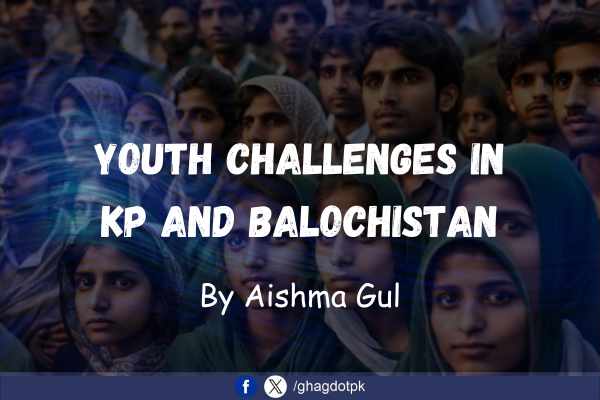By Aishma Gul
Khyber Pakhtunkhwa’s snow-capped mountains and Balochistan’s arid plains showcase the provinces’ natural resilience. Similarly, their youth possess untapped potential but face strong headwinds: poverty, inequality, and extremism that can either hold them back or fuel their determination. In Khyber Pakhtunkhwa and Balochistan, the youth demographic holds the key to unlocking the region’s future. With a significant proportion of their populations – 36% in KP and 32% in Balochistan – falling within the 15-29 age group, according to the Pakistan Bureau of Statistics, the youth will play a pivotal role in shaping the socio-economic and security landscape of these critical regions.
Socio-Economic and Security Contributions
Youth from KP and Balochistan have actively contributed to national defense, particularly through their involvement in military operations. According to a report by the United Nations Development Programme (UNDP), youth from these regions are actively involved in community-building initiatives and counterterrorism efforts. However, they also face unique challenges that make them vulnerable to extremist influences.
During his press conference on August 5, 2024, DG ISPR Lieutenant General Ahmed Sharif Chaudhry emphasized the military’s role in empowering young people, particularly through projects in education, health, and information technology. These initiatives are aimed at creating employment opportunities and fostering national unity, highlighting the importance of youth in securing Pakistan’s future.
Challenges Faced by Youth
Lack of Education and Unemployment Opportunities
KP and Balochistan lag in educational and employment development. According to the Pakistan Social and Living Standards Measurement Survey (PSLM), KP has a literacy rate of around 55%, while Balochistan’s is only 40%. Unemployment among the youth in these regions remains significantly higher than the national average, with youth unemployment at 10.8% in KP and 13.2% in Balochistan. The lack of opportunities leads many young people toward extremist activities, as terrorist groups exploit their grievances and economic frustrations.
Digital Terrorism
A concerning trend in recent years is the recruitment of young people in digital terrorism. According to the Digital Rights Foundation, extremist organizations have increasingly turned to social media and digital platforms to spread their ideologies. Youth in KP and Balochistan, who lack adequate digital literacy and economic opportunities, are often targeted by these groups. According to the Centre for Research and Security Studies (CRSS), over 60% of violent activities in Pakistan during the first quarter of 2024 were concentrated in KP and Balochistan. These regions accounted for 92% of fatalities during this period, and young people played a significant role in these insurgencies.
Geopolitical Isolation and Marginalization
Both KP and Balochistan have long faced marginalization in terms of infrastructure and development. A report by the Human Rights Commission of Pakistan (HRCP) highlights the underdevelopment in these regions, with poor access to education, healthcare, and employment opportunities contributing to a sense of alienation among the youth. The absence of stable, long-term development initiatives has made it difficult for youth to find meaningful participation in the country’s economic and political life
Conclusion
The challenges faced by the youth in KP and Balochistan highlight the need for targeted development initiatives that focus on education, employment, and digital literacy. As DG ISPR Lt. Gen. Ahmed Sharif Chaudhry underscored in his recent press conference, empowering young people through military-backed socio-economic initiatives is essential to the nation’s security and prosperity. On September 6, 2024, during Pakistan’s Defence Day commemorations, Chief of Army Staff (COAS) General Syed Asim Munir emphasized the role of youth as the country’s greatest asset, reiterating the importance of youth-driven national progress. Without these efforts, the risks of youth involvement in digital terrorism and extremism will continue to grow. However, with proper investment and measures, these young individuals can drive the nation toward a more stable and prosperous future.






